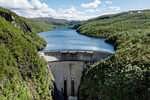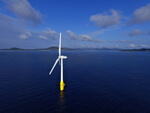News Release from American Clean Power Association (ACP)
Wind Industry Profile of
11/21/2011
AWEA Blog - Commentary on recent a comparison between energy output from oil pipelines with that of the wind power industry
Robert Bryce, an energy commentator from the Manhattan Institute (which receives funding from oil and gas interests), wrote a recent National Review article comparing the energy output from an oil pipeline with that of the wind power industry. The following response was posted as a comment.
Mr. Bryce’s article is provocative, but misleading. One need only look at his paragraph on jobs, which compares construction and permanent jobs that would be produced by the pipeline, not with actual jobs produced by the wind energy industry, but instead with the jobs lost because of the failure of a single innovative solar company.
Here’s a different idea: let’s try to make more of an apples-to-apples comparison on jobs. That would mean setting up the 13,000 construction and 7,000 manufacturing jobs cited for the pipeline against the 75,000 jobs in the wind farm industry today. Advantage: wind.
Mr. Bryce also misleads on wind power’s land use, claiming that wind turbines “cover” thousands of square miles of land. But wind turbines--and their supporting infrastructure, including roads and electrical substations, actually occupy only a small fraction--2% to 5%--of that land. In the remaining 95% to 98%, compatible land uses such as farming and ranching can continue undisturbed, which means that wind power provides farmers and ranchers with an extra cash crop that can help them stay on the land.
But let’s step back and look at the larger question Mr. Bryce raises: does wind power really make sense as an energy policy option?
Let’s assume that in the next year or two, wind power will catch up, and generate as much electricity as all the oil flowing through the pipeline. (That’s a reasonable assumption--in 2010, wind generated nearly 16 times as much electricity as in 2000, and it’s continuing to grow.) When it does, how will it compare?
1) Wind power won’t produce any pollution--today, tomorrow, or over the next 10 years or 20 years. In 2008, the National Academy of Sciences estimated what it called the “hidden costs” of burning fossil fuels at $120 billion per year (not including any impacts from greenhouse gases). These hidden costs are largely health costs from pollution.
2) Wind power won’t require any fuel. By contrast, using Mr. Bryce’s numbers and current oil prices, American consumers will pay $25 billion a year for the oil the pipeline delivers--and there’s no guarantee that fuel prices won’t rise.
3) Land is admittedly needed for wind farm generation, but that in turn means that the economic benefits of wind power are inevitably spread among the farmers and ranchers who host wind turbines on their land. In the case of wind, what "sprawl" really means is providing clean, low-cost, renewable energy and good-paying jobs for Americans, while putting money in the pockets of farmers and generating property tax revenues for rural communities across America's heartland.
4) In the course of creating the wind power industry, we’ve created a potent new source of American manufacturing jobs. As recently as 2005, only about 25 percent of the content of wind turbines installed in the U.S. was domestic. Today, that number is more than 60 percent, and there are more than 400 factories from coast to coast producing wind turbine components. A recent report from the nonpartisan Congressional Research Service (CRS) on the wind power industry underlines this, finding that 1) domestic content of turbines is indeed increasing rapidly and 2) turbine manufacturing creates good jobs in heavy industry.
Again, advantage: wind.
The aforementioned press release is only for purposes of information to the windfair.net community and does not reflect the opinion of any windfair.net staff and affiliated entities.
For more information on this article or if you would like to know more about what www.windfair.net can offer, please do not hesitate to contact Trevor Sievert at ts@windfair.net
www.windfair.net is the largest international B2B Internet platform – ultimately designed for connecting wind energy enthusiasts and companies across the globe!
Mr. Bryce’s article is provocative, but misleading. One need only look at his paragraph on jobs, which compares construction and permanent jobs that would be produced by the pipeline, not with actual jobs produced by the wind energy industry, but instead with the jobs lost because of the failure of a single innovative solar company.
Here’s a different idea: let’s try to make more of an apples-to-apples comparison on jobs. That would mean setting up the 13,000 construction and 7,000 manufacturing jobs cited for the pipeline against the 75,000 jobs in the wind farm industry today. Advantage: wind.
Mr. Bryce also misleads on wind power’s land use, claiming that wind turbines “cover” thousands of square miles of land. But wind turbines--and their supporting infrastructure, including roads and electrical substations, actually occupy only a small fraction--2% to 5%--of that land. In the remaining 95% to 98%, compatible land uses such as farming and ranching can continue undisturbed, which means that wind power provides farmers and ranchers with an extra cash crop that can help them stay on the land.
But let’s step back and look at the larger question Mr. Bryce raises: does wind power really make sense as an energy policy option?
Let’s assume that in the next year or two, wind power will catch up, and generate as much electricity as all the oil flowing through the pipeline. (That’s a reasonable assumption--in 2010, wind generated nearly 16 times as much electricity as in 2000, and it’s continuing to grow.) When it does, how will it compare?
1) Wind power won’t produce any pollution--today, tomorrow, or over the next 10 years or 20 years. In 2008, the National Academy of Sciences estimated what it called the “hidden costs” of burning fossil fuels at $120 billion per year (not including any impacts from greenhouse gases). These hidden costs are largely health costs from pollution.
2) Wind power won’t require any fuel. By contrast, using Mr. Bryce’s numbers and current oil prices, American consumers will pay $25 billion a year for the oil the pipeline delivers--and there’s no guarantee that fuel prices won’t rise.
3) Land is admittedly needed for wind farm generation, but that in turn means that the economic benefits of wind power are inevitably spread among the farmers and ranchers who host wind turbines on their land. In the case of wind, what "sprawl" really means is providing clean, low-cost, renewable energy and good-paying jobs for Americans, while putting money in the pockets of farmers and generating property tax revenues for rural communities across America's heartland.
4) In the course of creating the wind power industry, we’ve created a potent new source of American manufacturing jobs. As recently as 2005, only about 25 percent of the content of wind turbines installed in the U.S. was domestic. Today, that number is more than 60 percent, and there are more than 400 factories from coast to coast producing wind turbine components. A recent report from the nonpartisan Congressional Research Service (CRS) on the wind power industry underlines this, finding that 1) domestic content of turbines is indeed increasing rapidly and 2) turbine manufacturing creates good jobs in heavy industry.
Again, advantage: wind.
The aforementioned press release is only for purposes of information to the windfair.net community and does not reflect the opinion of any windfair.net staff and affiliated entities.
For more information on this article or if you would like to know more about what www.windfair.net can offer, please do not hesitate to contact Trevor Sievert at ts@windfair.net
www.windfair.net is the largest international B2B Internet platform – ultimately designed for connecting wind energy enthusiasts and companies across the globe!
- Source:
- American Wind Energy Association
- Author:
- Posted by Trevor Sievert, Online Editorial Journalist / By Tom Gray, www.awea.org/blog/
- Email:
- windmail@awea.org
- Link:
- www.awea.org/...
- Keywords:
- awea, wind, wind energy, wind turbine, rotorblade, awea, ewea, wind power, suppliers, manufacturers, renewable energy, trevor sievert


























